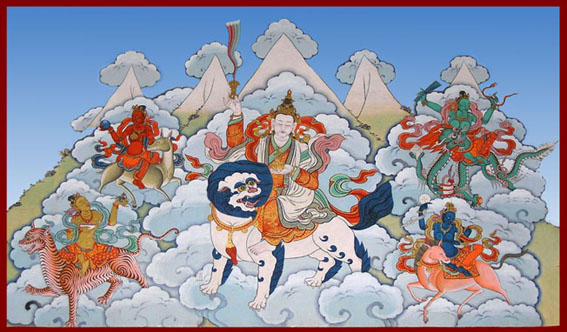Five Sisters of Long Life
Five Sisters of Long Life (tshe ring mched lnga) - protectoress of the Dharma, embodied as the mthon thing rgyal mo or Gaurishankar mountain -- syn (jo mo tshe ring mched lnga) 'The five sisters of Long Life', they are:
- Tashi Tseringma (bkra shis tshe ring ma),
- Tingi Shalzangma (mthing gi zhal bzang ma),
- Miyo Losangma (mi g.yo blo bzang ma),
- Chöpen Drinsangma (cod dpan mgrin bzang ma) and
- Täkar Drosangma (gtal dkar ´gro bzang ma).
Worshipped by all schools, they are particularly popular with the various Kagyu schools because of their connection with Jetsun Milarepa and his lineage.
According to the (tshe ring mched lnga'i bka' gtad kyi zur 'debs sman btsun dgyes pa'i zur mig), by (mkhas dbang sangs rgyas rdo rje) (1569-1645), a Drukpa Kagyu master and disciple of the great fourth Gyalwang Drukpa Pema Karpo (1527-1592), (bkra shis tshe ring ma) and her sisters took their first oaths from the dakini seng gdong ma in the great charnel ground "Singha" (this name is not mentioned among the various lists of the eight great charnel grounds of India).
Later they took further oaths from Guru Padmasambhava in Kham, at a place named zla nyi kha la rong sgo (where he concealed the gter ma of bla ma'i thugs sgrub bar chad kun sel and made them promise to be the guardians of this cycle of teachings). Then they took more oaths in the charnel ground called mun pa sgra sgrogs in India from the mahasiddha Krishnacharya (nag po spyod pa); and finally from Jetsün Milarepa at yongs rdzong in Tibet.
Together with Karag Khyungtsünma (kha rag khyung btsun ma), who is one of the twelve Tenma goddesses (bstan ma bcu gnyis), they are the special protectors of the Lamey Thukdrub Barche Künsel terma cycle, rediscovered by the great treasure finder (gter ston) Chokgyur Dechen Lingpa (1829-1870). Their residence is said to be (jo mo gangs dkar), a (supposedly) five peaked snow mountain on the border of Tibet and Nepal. Another name for this mountain is (mthon thing rgyal mo), the Nepalese Gaurishankar.
In the lha sman bkra shis tshe ring ma'i sgo nas 'jig rten dang 'jig rten las 'das pa'i rjes gnang bkra shis tshe dbang rab rgyas (bka' brgyud sngas mdzod, vol. 6, pp. 493-526, by Jamgön Kongtrul Lodrö Thaye (1813-1899), we read several accounts on how the tshe ring ma sisters repeatedly appeared to various lineage masters, aided them and renewed their oaths with them. At and immediately after Milarepa's time, they appeared to his close disciples like Gampopa, Rechungpa, Ngendzong Repa and Repa Shiwa Ö etc. and repeatedly helped and advised them. The instructions and transmissions for the practices of the tshe ring ma sisters were, among others, all given to Milarepa's sun-like disciple Dagpo Da-Ö Shönnu (sgam po pa), (1079-1153) who passed them on to his students. From there on onwards, these were handed down within all the four major and eight minor Kagyü-schools until the present day.
Through the first Karmapa Düsum Khyenpa (1110-1193) these were transmitted into the Karma Kagyu tradition. He had repeated visions of them, as did Drukpa Gyalwang Je and Drigung Chöying Rangdrol. Among many other masters, they also appeared to the third Karmapa Rangjung Dorje (1284-1339), the ninth Karmapa Wangchuk Dorje (1556-1603) and the sixth Shamarpa Garwang Chökyi Wangchuk (1584-1630), who composed the tshe ring mched lnga'i mchod gtor gyi rim pa, the main Tsheringma practice text in use nowadays by monastic communities of the Karma Kagyu (bka' brgyud sngags mdzod), vol. 6, pp. 437-460.
When the omniscient eigth Tai Situ Rinpoche Chökyi Jungne (1700-1774) was traveling to Nepal, he met the tshe ring ma sisters in actuality and received much advice from them. There are many stories about how they, until the present day, again and again appear to many practitioners of the various Kagyü lineages and aid and advise them.
- Translated by Thomas Roth (Sherab Drime)
